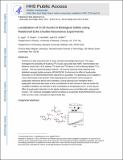Localization of Cl-35 nuclei in biological solids using rotational-echo double-resonance experiments
Author(s)
Iuga, D.; Rossi, P.; Herzfeld, J.; Griffin, Robert Guy
DownloadAccepted version (1.059Mb)
Terms of use
Metadata
Show full item recordAbstract
Chloride ions play important roles in many chemical and biological processes. This paper investigates the possibility of localizing ³⁵Cl nuclei using solid-state NMR. It demonstrates that distances shorter than 3.8 Å, between ¹³C atoms and ³⁵Cl atoms in 10% uniformly labeled ¹³C L-tyrosine·HCl and natural abundance Glycine·HCl can be measured using rotational-echo (adiabatic passage) double-resonance (RE(AP)DOR). Furthermore the effect of quadrupolar interaction on the REDOR/REAPDOR experiment is quantified. The dephasing curve is plotted in a three dimensional chart as a function of the dephasing time and of the strength of quadrupolar interaction felt by each orientation. During spinning each orientation feels a quadrupolar interaction that varies in time, and therefore at each moment in time we reorder the crystallite orientations as a function of their contribution to the dephasing curve. In this way the effect of quadrupolar interaction on the dipolar dephasing curve can be fitted with a polynomial function. The numerical investigation performed allows us to generate REDOR/REAPDOR curves which are then used to simulate the experimental data.
Date issued
2017-04Department
Massachusetts Institute of Technology. Department of Chemistry; Francis Bitter Magnet Laboratory (Massachusetts Institute of Technology)Journal
Solid State Nuclear Magnetic Resonance
Publisher
Elsevier BV
Citation
Iuga, D. et al. "Localization of Cl-35 nuclei in biological solids using rotational-echo double-resonance experiments." Solid State Nuclear Magnetic Resonance 82-83 (April 2017): 35-41 © 2017 Elsevier Inc
Version: Author's final manuscript
ISSN
0926-2040